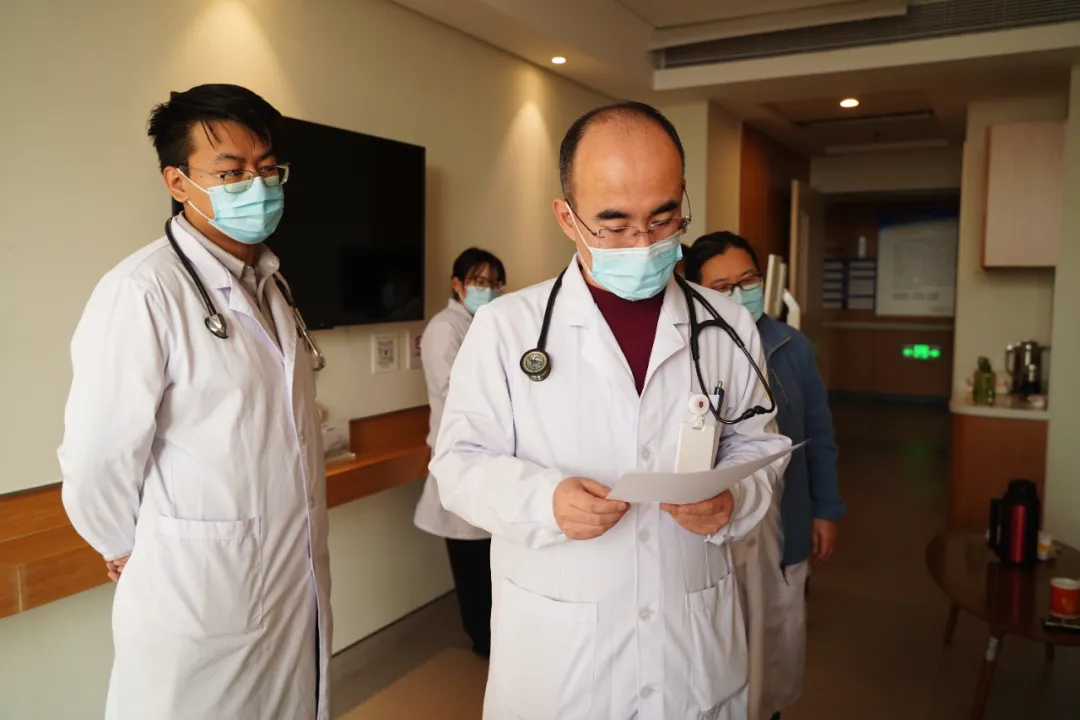For the past five years, repeated palpitations, chest tightness, and other symptoms have accompanied 78 year old Grandma Wang. She was diagnosed with persistent atrial fibrillation at a local hospital and was repeatedly hospitalized for medication treatment. However, the ventricular rate control effect was poor, and her heart function deteriorated. In the past month, Grandma Wang not only experienced a decrease in her activity tolerance, but also couldn't even lie flat. Through hospital promotion, she learned that Qingdao University Affiliated Rizhao Hospital/Rizhao Heart Disease Hospital has a professional cardiac electrophysiology clinic, so she came to the hospital for treatment.
After completing relevant examinations, the second main diagnosis group of the cardiology department diagnosed "acute exacerbation of chronic heart failure, complete left bundle branch block, persistent atrial fibrillation, dilated heart disease, hyperuricemia, renal dysfunction..." Due to the inability to effectively control the ventricular rate caused by rapid atrial fibrillation after optimizing drug treatment in the early stage, the patient's heart dysfunction has progressed to the stage of severe heart failure. Complete left bundle branch block can lead to asynchronous cardiac contractions, further exacerbating heart failure.
Putting patient interests first and providing the best diagnosis and treatment plan
Faced with such a complex illness, Qingdao University Affiliated Rizhao Hospital/Rizhao Heart Disease Hospital has always faced difficulties. In response to Grandma Wang's urgent need to address rapid atrial fibrillation and complete left bundle branch block, the second main consultation group of the cardiology department has decided to perform a one-stop surgery of "left bundle branch area pacing+atrioventricular node ablation" after multiple discussions on the condition. This not only effectively controls heart rate, restores cardiac contraction synchrony, and corrects heart failure, but also enables good control of ventricular rate, making it the best treatment plan for patients.
The combination of left bundle branch pacing and atrioventricular node ablation surgery is an innovative technology in the field of cardiac pacemakers and electrophysiology in recent years, suitable for patients with atrial fibrillation combined with heart failure and poor ventricular rate control. Rapid atrial fibrillation can directly lead to heart failure, and ablation of the atrioventricular node can alleviate the adverse effects of atrial fibrillation on heart failure. At the same time, left bundle branch pacing, as a physiological pacing, can maximize the synchronization of postoperative cardiac contractions and improve cardiac function in patients.
One stop surgery to restore heart rhythm and regain a healthy heart

Under the leadership of the leader of the second main consultation group in the Department of Cardiology, the leader of the Arrhythmia Department in Rizhao City, and Dr. Xie Xinxing, the one-stop surgery of "left bundle branch area pacing+atrioventricular node ablation" was carried out as scheduled. Dr. Gao Tingwen, a doctor of cardiology, first implanted a left bundle branch pacing electrode for Grandma Wang, punctured a blood vessel, and then delivered the pacing electrode along the vessel to the heart. The electrode was twisted from the right ventricular septum to the left bundle branch area below the intima of the left ventricular septum, and a long-lived pacemaker was implanted. Subsequently, under the guidance of the 3D mapping system, Director Xie Xinxing continued to perform atrioventricular node ablation for the patient. The atrioventricular node was accurately located through an ablation catheter, and after successful localization, ablation blocked atrioventricular conduction. The pacemaker immediately began pacing work, consolidating that after ablation, the heart contracted to a synchronous and regular state. Immediately after surgery, the electrocardiogram showed a significant narrowing of the QRS wave, which returned to the normal range. The surgery ended smoothly.
After the surgery, Grandma Wang's symptoms of palpitations and chest tightness were significantly relieved, and she finally lay down and had a good sleep that night. On the second day after surgery, Grandma Wang started walking on the ground and was discharged smoothly four days later. One month later, the follow-up cardiac ultrasound results showed that the ejection fraction of the heart increased from 29.98% before surgery to 45%, and the heart achieved "synchronized walking". The problems of "random beating, palpitations, and shortness of breath" disappeared. Grandma Wang repeatedly thanked the doctor for making her feel at ease.
Qingdao University Affiliated Rizhao Hospital/Rizhao Heart Disease Hospital always puts patients at the center, constantly exploring and developing cutting-edge medical technologies. For patients who require cardiac pacing, routine use of left bundle branch pacing technology avoids the occurrence of pacemaker mediated cardiomyopathy and heart failure without increasing medical costs. In the future, hospitals will take technological innovation as the lead, climb the medical peak forever, and provide accurate, safe, and efficient diagnosis and treatment services for more patients with pan vascular diseases, so that every patient can enjoy a high-quality life.
